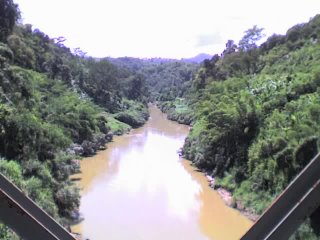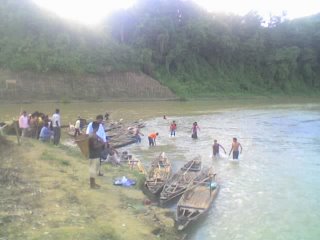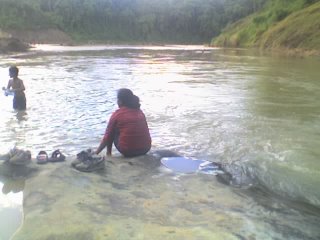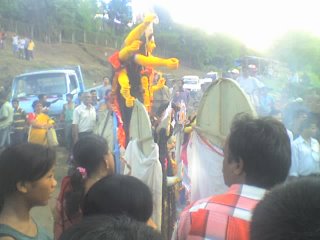
 It's my last full day in Aizawl. Tipi arrives as promised with her 8-year old son, Mamma, in tow. I learn her full name is Lalthanpuii. It's Bijoya Dashami / Dussehra / Gandhi's Birth Anniversary and the market is closed, so we decide we'd rather go down to the river and wash our souls! Leaving Aizawl for the drive down to Sairang, we are held up in a traffic jam. Trucks entering the city, trucks triple parked on the narrow hill road, trucks doing what they do everywhere in India leaves us unmoving for an hour. This is the National Highway and leads to Silchar and Guwahati in Assam and according to our taxi driver, Arama, is the day for commercial goods road transport to arrive in Aizawl. While we wait, Mamma figures out how to play the games on my cellphone, something I haven't even bothered with. How do these 8-year olds instinctively know?
It's my last full day in Aizawl. Tipi arrives as promised with her 8-year old son, Mamma, in tow. I learn her full name is Lalthanpuii. It's Bijoya Dashami / Dussehra / Gandhi's Birth Anniversary and the market is closed, so we decide we'd rather go down to the river and wash our souls! Leaving Aizawl for the drive down to Sairang, we are held up in a traffic jam. Trucks entering the city, trucks triple parked on the narrow hill road, trucks doing what they do everywhere in India leaves us unmoving for an hour. This is the National Highway and leads to Silchar and Guwahati in Assam and according to our taxi driver, Arama, is the day for commercial goods road transport to arrive in Aizawl. While we wait, Mamma figures out how to play the games on my cellphone, something I haven't even bothered with. How do these 8-year olds instinctively know?
Sairang is a village way down the Aizawl slopes, through which the river Tlawng flows. We snack on some local fried stuff at Tipi's cousin's shop and then make our way down to the river to discover that the immersion ceremonies for Durga have begun. We watch for a while and I explain to Tipi whatever little I know about what's happening. We go away from this spot to some rocks where a mountain stream joins the Tlawng. 

The water is muddy, but beautifully cold. We soak our feet in the current and drink “lokkul” as Mamma joins the local kids splashing about in the shallows. One part has depth and the local kids jump off the high rocks and cliffs into the waters, thoroughly enjoying themselves. The light is changing to dusk and we decide to head back to Aizawl, a pleasant buzz in our heads.
**********
The evening brings an invitation for drinks to Mr Lalthanhawla, the former Chief Minister's residence in Zarkawt in the heart of the city. Ravi was a dear friend of his son who died of an overdose a few years ago. Ravi has immense respect for the man, considering him a father figure, and it is obvious Mr Lalthanhawla too is fond of my friend. My past jobs have brought me into contact with a number of politicians, but they have been of a purely official nature. This is the first time a former Chief Minister has served me a drink with his own hands and I feel privileged. Like all Mizos, he is a warm and welcoming host. He is erudite, learned, and extremely well informed. It's been about 2 years since he lost his “gaddi” as he puts it charmingly, and while regretting the quality of Scotch he was serving he laughingly told us that he himself is a victim of the prohibition policy that was enacted by him while in power. I ask why he brought in this policy, and his answer is straightforward, “The Church... and the people.”
He served me a sweet local brew, of rare vintage, fermented from the traditional sticky rice of these parts of the North East. It was certainly very different from what I had drunk in the afternoon. He conceded it to be a good afternoon drink, to be had before a hearty lunch, which I conceded to as a gentle hint to get on with my Scotch!
I finally had the right man to ask, what I now myself was getting irritated with as an obsessive question, about Mizoram's economy. He has been the most popular CM and I think the longest serving one, having given up his gaddi willingly to bring peace to this insurgency-torn, beautiful land. The peace accord with the then underground Mizo National Force and Mr Laldenga, their leader in exile, required one to voluntarily step down from his elected position as CEO of the State, and the other to lay down arms. Of course, Mr Lalthanhawla was soon back where he belonged, and it is evident that he speeded up progress and instituted projects which continue to benefit the populace. The MNF returned to power recently, and I had already heard from local folks that the current CM, Zoramthanga, is hardly as efficient. Perhaps it won't be long before the person who was my host this evening will regain his lost position.
Mr Lalthanhawla told me that 20 years of insurgency had brought poverty to his land, once self-sufficient in food grains, untrammelled by urbanisation, and beautiful. The MNF and allied forces had raped their own land and its people in the quest of some elusive Utopia. To counter the insurgents, the bigger powers in Delhi decided to do some raping of their own. The Army was installed in all its might in Mizoram, and as if that was not enough, on the 5th or 6th March 1966, the Indian Air Force strafed and bombed Aizawl, leaving thousands of innocent people dead, destroying a beautiful hill-station and engendering the hate and anger that Mizos and other North Easterners have for the military in particular, and “Indians” in general. All this led to a massive exodus of people from the interior rural areas into Aizawl seeking food, shelter and income. So Aizawl is now this overgrown, unplanned city groaning under the weight of its population, sorely lacking in infrastructure and opportunity.
The Centre realised too late its typical stupidity, and tried to make amends by giving people jobs in the Central ministry departments, apart from all the frantic subsidising and grants they dished out as charity to a state which never would have required such sops. This then is the background to the sarcastic remark I heard a few days ago telling me that the India Government is what the economy of Mizoram is based on. But Mr Lalthanhawla is specific. He says Mizoram's economy is based on agriculture and must continue that way for a return to self-sufficiency and prosperity. I am not that naïve a person to believe every word a politician says, but the ring of conviction in Mr Lalthanhawla's voice and my own observations tells me he is right. That is heartening news for our country now gradually running amuck with uncontrolled urbanisation. We need to return to earth from the rarified atmosphere of globalisation and all the ills that it brings. The earth is where we are, and we need to touch it and love it once again.
I know for sure that if I once again exercise my franchise, something I no longer do, it will be to vote in Mr Lalthanhawla as the Prime Minister of India, rather than Mr Buddhadeb Bhattacharya of Bengal, who journalists and people in Calcutta and elsewhere are rooting for. I have no particular political stance or dogma but my reason for this decision is solid. Mr Lalthanhawla is of the land and wants to return there for a sustainable future. BB is also from the earth, but he's now sailing far out in the unrealism of globalisation, at the expense of farmers.
Mrs Lalthanhawla had been away at a wedding shower and joined us for a few minutes before we left, gracious in her unnecessary apologies. She must have been quite a stunning beauty when younger. As I took their leave, I knew I had enjoyed the company of a man, who given the opportunity, has an alternative and viable vision for the future of not just Mizoram, but India in its entirety and diversity.
(There's a reasonably well-researched articles from 2003 available from The Hindu online on and another from Frontline magazine on Mr Lalthanhawla and Mizo politics, if you're really keen that is...)

No comments:
Post a Comment